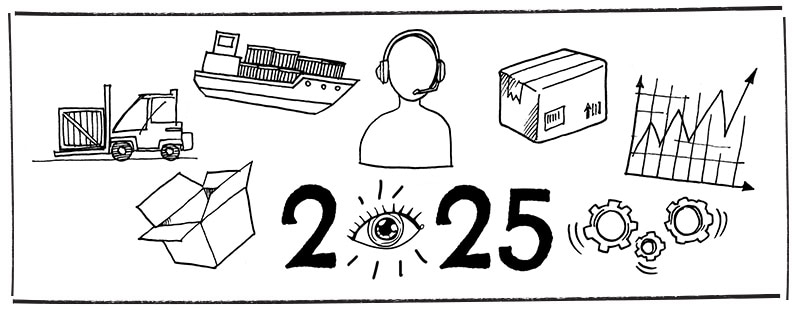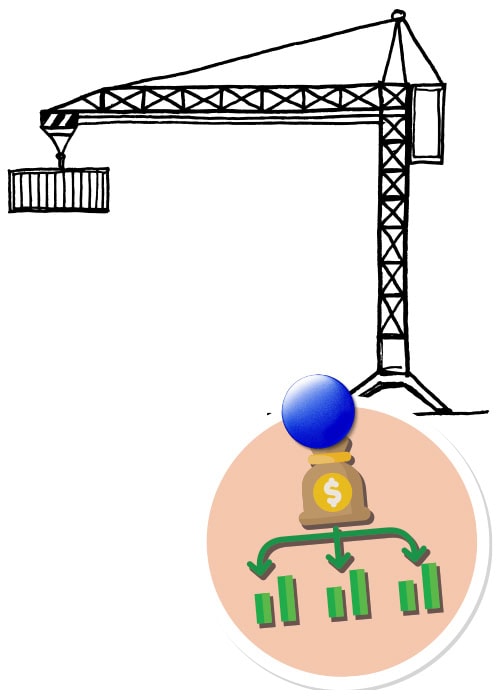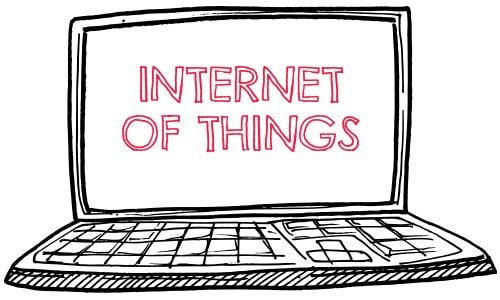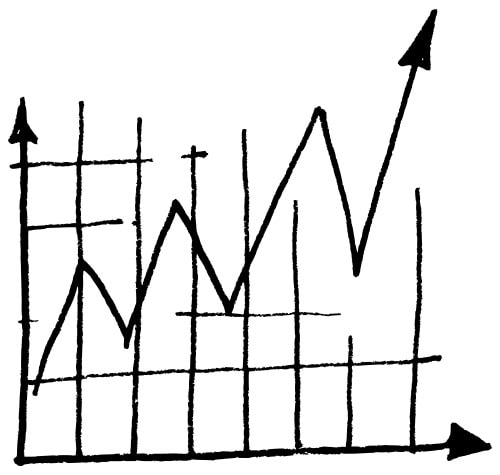What’s Your Supply Chain Vision for 2025?

From sure-fire predictions to major trends to watch, industry experts outline the year ahead.
Bold Pronouncements
Few electronics shortages. Unless geopolitical tensions in Taiwan worsen, I do not predict any major material or product shortages in the electronics sector. Expect progress to build on 2024 which had fewer shortages.
–Kenny McGee,
CEO and Founder,
Component Sense
 By the end of 2025, full truckload spot rates will have increased by 20% and contract rates will be up 5% year over year. But benchmarking rates against the broader market and pre-pandemic times will be a better performance measure than straight year-over-year comps.
By the end of 2025, full truckload spot rates will have increased by 20% and contract rates will be up 5% year over year. But benchmarking rates against the broader market and pre-pandemic times will be a better performance measure than straight year-over-year comps.
–Chad Kennedy,
Senior Manager, iQ Product, Benchmark Analytics,
DAT Freight & Analytics
Tariffs will NOT be the big issue they are being made out to be. The big issue will be over inventory positions companies will be in by trying to import pre-tariffs.
–Paul Magel,
President, Application Solutions Division,
Computer Generated Solutions (CGS)
More retailers than ever will shift volume to regional carriers, accelerated by the actions UPS, FedEx, and USPS are taking to improve profitability. As ecommerce parcel volume shifts to regional and next-generation carriers, legacy carriers will mitigate that volume loss by attempting to enter new categories, such as medical delivery.
–Itamar Zur,
CEO and Co-founder,
Veho
 Artificial intelligence being used for generalized purposes will be a bygone era. We will enter an era of industry-specific, or more accurately, vertical AI. It will run on specific systems—whether in the logistics, manufacturing, finance, or healthcare sector—with tailored capabilities that transform processes and decision-making from the ground up.
Artificial intelligence being used for generalized purposes will be a bygone era. We will enter an era of industry-specific, or more accurately, vertical AI. It will run on specific systems—whether in the logistics, manufacturing, finance, or healthcare sector—with tailored capabilities that transform processes and decision-making from the ground up.
–Chris Coote,
Head of Product,
Dexory
This year starts a new growth cycle, driven by a surge of optimism among CEOs. After years of uncertainty and disruption, business leaders will transition from survival mode to a growth-oriented mindset.
With supply chain challenges stabilizing and technological advancements picking up pace, CEOs will gain the confidence to make bold investments in innovation, talent development, and strategic expansion.
–Joe Galvin,
Chief Research Officer,
Vistage
 Many companies will require an entirely new frontline model due to persistent talent challenges. Previously, distribution faced truck driver shortages. Now, manufacturing leads with an expected 8% labor shortage by 2030.
Many companies will require an entirely new frontline model due to persistent talent challenges. Previously, distribution faced truck driver shortages. Now, manufacturing leads with an expected 8% labor shortage by 2030.
The U.S. labor market faces a 1.6 million shortfall. 36% of U.S. manufacturing employees plan to leave within 3-6 months, causing high attrition. This turnover, combined with new hire learning curves and digital transformations lacking sustained impact, creates labor productivity issues. The situation demands increased focus on labor productivity.
–Alberto Oca,
Partner,
McKinsey & Company
Climate change and corresponding resource scarcities will play a much bigger part in the global supply chain. We used to see a predictable seasonality for fruit, as a nationwide mover of produce, but 2024 weather pushed seasonality out of balance and stone fruits barely had a season at all. Supply chain stakeholders will need different skilled resources and expertise to respond to these changes and the associated trade disruptions.
–Jeff Pepperworth,
President and CEO,
iGPS Logistics
 Diversification intensifies. Supply chain leaders will adopt procurement strategies that support flexible sourcing (multiple suppliers and locations) and nearshoring to reduce shipping times, transportation costs, and geopolitical risks.
Diversification intensifies. Supply chain leaders will adopt procurement strategies that support flexible sourcing (multiple suppliers and locations) and nearshoring to reduce shipping times, transportation costs, and geopolitical risks.
Fortifying supply chains to secure critical infrastructure and strengthen national defense against foreign adversary threats is the focus in the United States. We face an increase in foreign ownership of U.S. companies and a dependency on foreign suppliers, signaling the need for supply chain diversification.
–Brian Filanowski,
General Manager: Finance & Risk and Capital Markets,
Dun & Bradstreet
Disruption? No problem. More organizations than one would expect will carry on without much disruption when the next Black Swan happens—whether it’s an avian influenza pandemic, a catastrophic storm, or an unexpected outbreak of hostilities elsewhere. Certainly, many organizations failed to learn the lessons of the pandemic. But predictive AI, multi-sourcing, and investment in increasing supply chain resiliency will enable a surprising number of companies to carry on with little disruption to operations.
–Steve Bassaw,
Product Manager,
SYSPRO
 IoT standardization will become critical for traceability and transparency in food and beverage. Recent large-scale foodborne illness outbreaks like those at McDonald’s, Boar’s Head, and others are driving an increased focus on traceability and transparency. As a result, expect higher investment in technology, such as IoT standardization, as well as tighter sourcing scrutiny.
IoT standardization will become critical for traceability and transparency in food and beverage. Recent large-scale foodborne illness outbreaks like those at McDonald’s, Boar’s Head, and others are driving an increased focus on traceability and transparency. As a result, expect higher investment in technology, such as IoT standardization, as well as tighter sourcing scrutiny.
IoT standardization on temperature and sensory data will also be critical for traceability and transparency in pharma, high-tech, and high-value goods.
–Stephen Dyke,
Principal Solutions Consultant Manager,
FourKites
Up or Down? In or Out?
M&A activity in the logistics market: UP↥
The trend of M&A will continue in the brokerage industry. Increased scale allows strategic providers to offer customers a wider array of services and the ability to invest across all parts of the freight cycle.
–Jared Weisfeld,
Chief Strategy Officer,
RXO
Less-than-truckload demand: UP↥
 LTL will see a higher demand for precision delivery as companies manage tighter inventories. After the pandemic, companies face increased pressure to reduce costs and streamline operations, leading them to re-evaluate their inventory positions and shift toward a leaner stock level. As a result, businesses are becoming more focused on precise, just-in-time delivery to maintain efficiency without holding excess inventory. As companies manage tighter inventories, there will be a greater need for smaller, frequent, and reliable on-time deliveries to ensure stock levels meet demand without excess.
LTL will see a higher demand for precision delivery as companies manage tighter inventories. After the pandemic, companies face increased pressure to reduce costs and streamline operations, leading them to re-evaluate their inventory positions and shift toward a leaner stock level. As a result, businesses are becoming more focused on precise, just-in-time delivery to maintain efficiency without holding excess inventory. As companies manage tighter inventories, there will be a greater need for smaller, frequent, and reliable on-time deliveries to ensure stock levels meet demand without excess.
–Frank Granieri,
Chief Operating Officer,
A. Duie Pyle
Embedded fraud prevention: UP↥
Supply chains will see a significant shift toward integrated fraud prevention measures, moving away from reactive, stand-alone approaches. A particular focus will be on combating the rise in fraud through standardized verification processes and trusted partner networks.
–Jared Palmer,
Head of Transportation & Logistics,
Tint
 Regionalization: UP↥
Regionalization: UP↥
Supply chains will see a seismic shift toward regionalized manufacturing and logistics hubs, bringing production closer to the point of delivery. For decades, globalization has been the backbone of supply chains, but rising costs, geopolitical pressures, and the demand for faster delivery are driving a major change.
Companies will move away from extended, complex supply chains and instead invest in nearshoring and regionalized operations. This trend isn’t just about speed; it’s about reliability and control. The future is local.
–Jeffery Benore,
President and CEO,
Benore Logistic Systems
Fraudulent returns will spur innovation in returns management. Ecommerce retailers lose billions of dollars due to fraudulent returns. There will be a shift toward solutions that tackle this issue directly, including unboxed returns models where items are picked up directly from the consumer’s doorstep without requiring repackaging. More companies will begin to use AI-powered image recognition to confirm the correct item is being returned, preventing fraudulent returns by catching discrepancies.
–Dennis Moon,
COO & Head of Operations,
Roadie
↥ Continued focus on nearshoring/onshoring
↥ Decentralized team transformations and outsourcing
↥ Capacity building in the United States and EU
–Michelle Peters,
CEO,
Supplino
Big global forwarders: DOWN↧
 Mega global forwarders will lose ocean freight market share to smaller and mid-sized freight forwarders due to market shifts favoring flexibility and customer-specific solutions. Smaller players can offer more adaptable, niche services, catering to specialized needs such as unique commodity handling, specialized shipping services, and expedited handling. Furthermore, advancements in digital freight forwarding applications and real-time tracking enable these companies to compete without the overhead of the global mega forwarders.
Mega global forwarders will lose ocean freight market share to smaller and mid-sized freight forwarders due to market shifts favoring flexibility and customer-specific solutions. Smaller players can offer more adaptable, niche services, catering to specialized needs such as unique commodity handling, specialized shipping services, and expedited handling. Furthermore, advancements in digital freight forwarding applications and real-time tracking enable these companies to compete without the overhead of the global mega forwarders.
–Jeffrey Plumley,
President,
ASF Liquid Logistics
The number of trucks in comparison to freight demand: DOWN↧
In short: freight contraction. Some good news for trucking companies (but could mean higher costs for businesses that rely on them) is that balance is returning in the market. For a while, there were too many trucks and not enough freight to haul. This led to lower rates for trucking companies. However, recently, the number of trucks has declined in comparison to the rising demand for freight, ACT reports, meaning trucking companies can charge higher rates for their services. It will not be a dramatic boom; however, the trend is positive, and rates are expected to continue rising for months.
–Asparuh Koev,
CEO,
Transmetrics
 Renewable energy: UP↥
Renewable energy: UP↥
Despite all the chatter around economic challenges, renewable energy in supply chains will have a banner year. Expect record-breaking adoption as companies double down on emissions reduction efforts.
–Matt Muenster,
Chief Economist,
Breakthrough
IN: deep relationships with a few providers↥
OUT: relying on a wide carrier base↧
Shippers will continue to establish deeper relationships with strategic providers instead of leveraging a wider carrier base.
–Jared Weisfeld,
Chief Strategy Officer,
RXO
BUT WATCH OUT
Shippers that reduce their carrier and broker base in order to leverage volume with the ones they want to keep will regret it. Cutting too many supplier contracts might leave them short as the market tightens.
–Chad Kennedy,
Senior Manager, iQ Product, Benchmark Analytics,
DAT Freight & Analytics
Geopolitical pressures: ESCALATING
The evolving dynamics of the U.S.-China trade war and other geopolitical tensions threaten to disrupt newly established sourcing patterns, requiring businesses to adapt.
–Sébastien Breateu,
Founder and CEO,
QIMA
 Global disruption: UP↥
Global disruption: UP↥
Overall, the global supply chain will experience increased disruption due to more severe weather events, armed conflict, and labor disputes. Additional targeted tariffs will shift some sourcing away from China toward next-tier low-cost areas, putting a strain on their transportation and port infrastructure.
–Chris Bear,
President,
sensified.io
SUPPLY CHAIN BUZZWORDS
 Inflation
Inflation
We have been experiencing the longest and deepest freight recession on record. With continued carrier exits due to unsustainable unit economics and a shift back toward the consumption of goods, we are likely to see freight rate inflation. Additionally, inflation on goods and services will remain top of mind for consumers as it has greatly impacted purchasing power the past few years.
–Jared Weisfeld,
Chief Strategy Officer,
RXO
Risk Mitigation
With an increasing sense of economic and geopolitical uncertainty in the air, proactive risk mitigation will take center stage.
–Chao-Ming Ying,
Chief Technology Officer,
New Horizon Soft
Cost-to-serve
In the face of geopolitical challenges ahead, organizations will need to leverage their supply chains to reduce costs. Traditional methods for margin improvement may no longer suffice, necessitating a granular assessment of cost-to-serve.
–Mary Rollman,
Supply Chain Leader,
KPMG
COLLABORATION
 Companies will lean on strong shipper-carrier partnerships to navigate disruptions and volatility.
Companies will lean on strong shipper-carrier partnerships to navigate disruptions and volatility.
–Matt Muenster, Chief Economist, Breakthrough
Collaboration can be a win-win. Every stakeholder is looking for ways to become more efficient, and this often involves working with suppliers and other partners to also make them more efficient, with mutual benefit. We see it in our own business, where retail partners within our pallet ecosystem, in an effort to improve their own costs, have provided opportunities to expand our footprint within their network.
–Jeff Pepperworth,
President and CEO,
iGPS Logistics
TECH TO WATCH
Artificial intelligence gets autonomous and predictive. While generative AI was all the rage in 2024, helping manufacturers write training manuals and documentation, create new processes, or distill information from IoT sensors, there’s also a new bot in town, in the form of AI agents and predictive quality analytics. 25% of enterprises using GenAI are expected to deploy AI agents in 2025, growing to 50% by 2027, Deloitte predicts.
–Vick Vaishnavi,
CEO,
ETQ
 Predictive AI. In the chaotic period we’re about to enter, predictive AI will become one of the most important technologies in the supply chain manager’s toolbox.
Predictive AI. In the chaotic period we’re about to enter, predictive AI will become one of the most important technologies in the supply chain manager’s toolbox.
–Steve Bassaw,
Product Manager,
SYSPRO
Agentic AI or the use of AI agents to help understand and simplify complex data sources. Agentic AI can provide calculations that most humans couldn’t even contemplate, which will help us come up with better solutions for inventory management, route optimization, supplier relationship management, operational efficiency, and so many other different areas of supply chain.
–David Warrick,
EVP, Enterprise,
Overhaul
Digital twins will help businesses simulate different scenarios to provide insights without the need to disrupt day-to-day operations.
–Chris Coote,
Head of Product,
Dexory
Autonomous supply networks (ASNs). ASNs will emerge as a defining buzzword as organizations move beyond linear supply chains to self-orchestrating networks powered by AI. Unlike traditional supply chains that require constant human intervention, ASNs will automatically sense disruptions, evaluate multiple response scenarios, and execute optimal solutions in real time. This represents a fundamental shift from “manage and respond” to “sense and adapt” operations, where AI systems coordinate complex decisions across multiple tiers of suppliers, manufacturers, and logistics providers.
–Mark Talens,
Executive Vice President, Chief Strategy & Solution Officer,
ParkourSC
 Humanoids. The acceleration of humanoid robotics has been incredible to watch, and there will continue to be significant advances from Figure, Agility, and others. That said, the biggest robotics impact in 2025 and the next few years will still be from purpose-built robots performing repetitive tasks such as picking, sorting, and moving goods inside and outside the warehouse walls.
Humanoids. The acceleration of humanoid robotics has been incredible to watch, and there will continue to be significant advances from Figure, Agility, and others. That said, the biggest robotics impact in 2025 and the next few years will still be from purpose-built robots performing repetitive tasks such as picking, sorting, and moving goods inside and outside the warehouse walls.
–Joe Wieciek,
Director of Technical Operations,
Outrider
BRIGHT SPOTS
Sustainable innovation remains a bright spot. There are more opportunities than ever to move goods sustainably while balancing cost constraints.
–Matt Muenster,
Chief Economist,
Breakthrough
 Healthy consumers; more goods. Despite high inflation rates and fears of a recession, the consumer and U.S. economy have remained resilient post-pandemic. Overall, consumer spending is improving while retail inventory positions remain healthy. We expect a reversion towards goods following a recent focus on experiences.
Healthy consumers; more goods. Despite high inflation rates and fears of a recession, the consumer and U.S. economy have remained resilient post-pandemic. Overall, consumer spending is improving while retail inventory positions remain healthy. We expect a reversion towards goods following a recent focus on experiences.
–Jared Weisfeld,
Chief Strategy Officer,
RXO
Suppliers and distributors are now better equipped to handle unexpected events. Investments in AI, digital supply chains, and multi-sourcing will continue to provide additional flexibility and control. Inventory levels have also become more normalized. Long lead times in the supply chain previously caused an excess of inventory. However, we now see a rightsizing of the amount of inventory to meet demand.
–Chandler Greer,
Vice President, Supply Chain,
ScanSource
 Implementing new technological resources will be a bright spot for companies and supply chain leaders. Respondents to McKinsey’s supply chain pulse survey report good progress in their efforts to improve supply chain intelligence, planning, and risk management. The share of respondents with comprehensive visibility of their tier-one suppliers reached 60%, making 2024 the second year in a row that this measure has increased by 10 percentage points.
Implementing new technological resources will be a bright spot for companies and supply chain leaders. Respondents to McKinsey’s supply chain pulse survey report good progress in their efforts to improve supply chain intelligence, planning, and risk management. The share of respondents with comprehensive visibility of their tier-one suppliers reached 60%, making 2024 the second year in a row that this measure has increased by 10 percentage points.
–Alberto Oca,
Partner,
McKinsey & Company
Technology democratization will empower smaller businesses to leverage tools such as AI and digital twins, improving their ability to compete.
–Chao-Ming Ying,
Chief Technology Officer,
New Horizon Soft
1. The pandemic cycle that began in spring 2020 and lasted 48 months—six months longer than usual—is over.
2. Slow, steady growth in truckload volumes should be an encouraging sign. Unless there’s a shock to supply chains, expect truckload rates, volumes, and demand for capacity to grow at a manageable clip.
–Chad Kennedy,
Senior Manager, iQ Product, Benchmark Analytics,
DAT Freight & Analytics
 Air cargo. The overall financial performance of airlines should improve, supported by lower jet fuel prices and other efficiency gains. Cargo demand will grow and freight rates are expected to be lower than they have been for the past decade. This will be supported by the unending growth of ecommerce as well as geopolitical uncertainty, particularly around sea shipments routed through the Suez Canal.
Air cargo. The overall financial performance of airlines should improve, supported by lower jet fuel prices and other efficiency gains. Cargo demand will grow and freight rates are expected to be lower than they have been for the past decade. This will be supported by the unending growth of ecommerce as well as geopolitical uncertainty, particularly around sea shipments routed through the Suez Canal.
–Richard Hakes,
Chair, Transportation Industry Group,
Reed Smith
BIGGEST POTENTIAL STUMBLING BLOCKS
 Weakening supplier relationships: Amid ongoing global trade uncertainties, strong supplier partnerships are crucial for resilience. Businesses that fail to nurture these relationships risk losing reliability and flexibility in their supply chains.
Weakening supplier relationships: Amid ongoing global trade uncertainties, strong supplier partnerships are crucial for resilience. Businesses that fail to nurture these relationships risk losing reliability and flexibility in their supply chains.
–Sébastien Breateu,
Founder and CEO,
QIMA
Over-reliance on single sources: Relying too heavily on a single supplier, region, or transportation method leaves businesses vulnerable to disruption. Whether it’s unexpected delays, natural disasters, or economic shifts, the solution lies in diversification—expanding networks, exploring regional options, and building flexibility into operations.
–Jeffery Benore,
President and CEO,
Benore Logistic Systems
Material shortages are a challenge for logistics to tackle, especially in the context of China denying the shipment of rare earth elements and commodities back to the United States. This has further implications for the supply chain, which will need to increase focus on efficiency in power, resource management, and manufacturing to combat any lack of trade with China.
–Kevin Novak,
Managing Partner & Founder,
Rackhouse Ventures
Carriers will confront a slow recovery. The freight recession, triggered by a slowdown in goods consumption, home construction, and manufacturing, combined with an influx of new carriers and collapsing rates, left many small trucking operations vulnerable. Despite this, carriers should leverage their pandemic-era savings to make strategic investments for long-term growth as the industry recovers.
–Nick Darman,
Founder and CEO,
Alvys
1. Signs that China will invade Taiwan, thus mass chaos in the supply chain similar to what we saw during the pandemic.
2. The United States becomes disinterested in policing international waterways, disrupting trade flows.
3. Escalation of U.S./China trade wars from the new administration, causing reshuffling of suppliers around the world.
–Steve Schlecht,
Director, Strategic Initiatives,
Buske Logistics
The Big Picture: 2025 Will Be…
 An AI tipping point—where machine learning systems become sophisticated enough to evaluate and accelerate many operational decisions. This convergence of artificial intelligence and vast data availability applied within the business context of supply chain performance will create the largest operational transformation since the invention of containerized shipping.
An AI tipping point—where machine learning systems become sophisticated enough to evaluate and accelerate many operational decisions. This convergence of artificial intelligence and vast data availability applied within the business context of supply chain performance will create the largest operational transformation since the invention of containerized shipping.
–Mark Talens,
Executive Vice President,
Chief Strategy & Solution Officer,
ParkourSC
All about cyber-security. Intensifying cybersecurity threats and supply chain disruptions will accelerate cloud adoption.
–John Carrico,
Vice President, Product Management,
Epicor
 Protection against cybersecurity incidents, which are becoming more frequent and severe, needs to be a top priority for the supply chain, which has historically underinvested in this area. As part of every digital transformation effort, it’s critical to evaluate existing systems and processes, putting security at the forefront.
Protection against cybersecurity incidents, which are becoming more frequent and severe, needs to be a top priority for the supply chain, which has historically underinvested in this area. As part of every digital transformation effort, it’s critical to evaluate existing systems and processes, putting security at the forefront.
–Matt Elenjickal,
Founder and CEO,
FourKites
Hungry for hyper localization
We’ll see a significant resurgence of localized production. Reshoring and nearshoring will become more popular as companies look to reduce risks from global disruptions and geopolitical tensions. This will bring manufacturing closer to home—shortening lead times and creating a more resilient supply chain. However, it will also force businesses to adopt advanced technologies such as high-tech manufacturing to remain competitive and efficient.
–Lion Shirdan, Co-Founder, JXB Global
Inventory placement will continue to expand closer to the final mile. Micro-fulfillment and faster delivery are the desired methods to succeed. 3D printing will revolutionize the industry.
–Harold Boyett,
CEO,
Blue Streak,
CLDA Board Member
 Diversifying diversification
Diversifying diversification
Many shippers began to diversify after the pandemic highlighted the need for greater supply chain agility and are not starting at square one. Beyond decoupling from China, shippers are also looking for diversification across modes, such as ocean to air, full containerload to less-than-containerload, and even shifts in inland strategies.
Diversification for supply chain agility remains crucial as it allows adaptability during changing market conditions. Shippers have made significant progress, but there’s still much work to be done.
–Mike Short,
President, Global Forwarding,
C.H. Robinson
How to Mitigate the Impact of Tariffs
By Darpan Seth, Co-Founder and CEO, Nextuple
 The proposed tariffs are expected to impact omnichannel retailers’ operations. The anticipated increased cost of imports will force buyers to either seek cheaper alternatives or absorb higher costs, thereby impacting profit margins. Contract negotiations with suppliers and vendors will be more challenging due to tariff-induced price fluctuations.
The proposed tariffs are expected to impact omnichannel retailers’ operations. The anticipated increased cost of imports will force buyers to either seek cheaper alternatives or absorb higher costs, thereby impacting profit margins. Contract negotiations with suppliers and vendors will be more challenging due to tariff-induced price fluctuations.
To mitigate these impacts in the mid-term, retailers are employing various strategies:
 ♦ Developing relationships with alternative suppliers in countries with more favorable trade agreements—for example, Walmart and Target diversified their sourcing beyond China. The downside is that this can lead to longer lead times and quality control issues.
♦ Developing relationships with alternative suppliers in countries with more favorable trade agreements—for example, Walmart and Target diversified their sourcing beyond China. The downside is that this can lead to longer lead times and quality control issues.
♦ Shifting manufacturing geographies, such as Steve Madden and Crocs moving production to Vietnam and Cambodia. This requires substantial investment and can disrupt existing supply chains.
♦ Adding “logistics hops” such as transshipment through tariff-free countries, as some apparel companies are doing. But this increases transportation costs and complexity.
These strategies require careful cost-benefit analysis, balancing tariff avoidance against operational complexity and potential supply chain disruptions.
